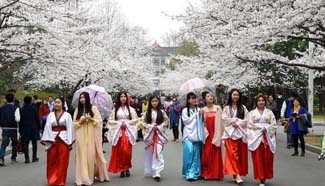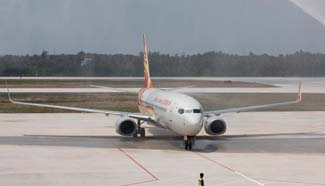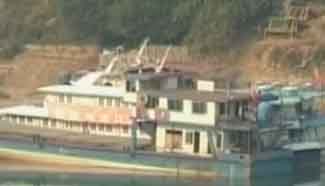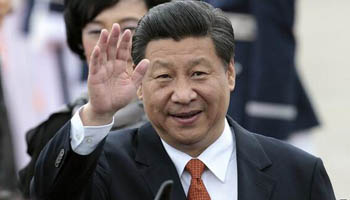China will cut its troop numbers by 300,000, President Xi Jinping said in a speech at commemorations of the 70th anniversary of the victory of the Chinese People’s War of Resistance Against Japanese Aggression and the war against Fascism on Sept. 3. Xi, also general secretary of the Communist Party of China Central Committee and chairman of the Central Military Commission (CMC), then reviewed China’s armed forces in Beijing’s Tian’anmen Square. After the event, Yang Yujun, spokesman for the Ministry of National Defense, answered questions at a press conference.
Q: Why China chose to announce the cuts at the military parade?
A: Our intention in holding the commemorative events and observing the Chinese people’s great sacrifice and great contribution is to keep history in mind, to honor those who laid down their lives, to cherish peace and build the future. The announcement by President Xi has fully demonstrated China’s wish and sincerity to safeguard peace, to strive for common development and share prosperity with other countries. It also showed China’s responsible attitude in pushing forward international arms control and military reductions.
Q: Why is China cutting its military?
A: Since the 1980s, China has cut its troop numbers three times – by 1 million, half a million and 200,000 respectively – to arrive at the current strength of 2.3 million. According to a decision of the third plenary session of the 18th CPC Central Committee on national defense and military reform, and after in-depth deliberations, the central leadership and President Xi decided to cut another 300,000 to reduce China’s troops to 2 million. The decision is in line with China’s national and military conditions. By cutting troop numbers, China’s armed forces will be smaller but more capable, and their structure more scientific, in line with efforts to build a modern military system with Chinese characteristics, and to build a strong army that can guarantee the realization of the “two 100-year goals” and the Chinese dream of national revival.
Q: After the cut of 300,000, China will still have the world’s largest standing army. Why China needs such a large army?
A: As a big developing country, China still faces many complicated security threats, problems concerning security and development, the intertwining of traditional and non-traditional threats, as well as the responsibility to safeguard national unity and territorial integrity and defend China’s development interests. The Chinese army is also tasked with non-military duties such as disaster relief, peacekeeping and international rescue. And we need to cope with the threat of regional terrorism, separatism and extremism. So our army needs to keep a certain scale that is defensive in nature. We will never follow the footsteps of big powers that sought hegemony once they grew strong. China will never seek hegemony, and never engage in military expansion. Some countries have been playing up the “China threat”, which is not in line with reality and not responsible.
Q: China has a complicated peripheral security situation. Is it risky to cut military strength at this time?
A: Cutting troops can help concentrate resources, boost information construction and enhance construction quality. We are confident that we can cope with various security threats and risks, and safeguard national sovereignty, security and interests.
Q: What troops will be cut? How long will the cuts take?
A: The established policy of the Chinese military is to unswervingly aim for fewer but more capable troops. The cuts will focus on troops equipped with outdated weapons, administrative staff and non-combatant personnel, while optimizing the structure of Chinese forces. The reform will adopt a gradual approach and will be accomplished by the end of 2017.
Q: Will the military cuts affect defense expenditure?
A: Compared with some other countries, China’s per capita national defense expenditure and the national defense expenditure to GDP ratio is not high. Many areas in China’s military construction need investment, and our weapons and equipment lag behind, adding to the heavy task of digital construction. As the economy grows and living standards rise, we need to ensure military wages keep pace with other professions, and we need to optimize the military social security system. To ensure national defense and military reform, especially the military cuts of 300,000, we need to increase spending on helping retired personnel. All of these require a proper level of national defense spending.
Q: Will money saved from the troop cuts be spent on developing nuclear, cyber and space forces?
A: China has always adhered to the policy of not using nuclear weapons first and a defensive nuclear strategy. We have always advocated peaceful use of outer space and opposed weaponization of outer space and space arms race. China is a major victim of cyber attacks; its infrastructure faces a severe threat. In these respects, our policies are consistent and our strategic intention is transparent. We will gradually improve military construction, which will be oriented by core national security needs.
Q: Does the announcement mean that this national defense and military reform has started?
A: After the third plenary session of the 18th CPC Central Committee, in which deepening national defense and military reform was planned, a reform leading group of the CMC has broadly studied and laid out measures, such as adjusting auditing mechanisms in the military and optimizing policy systems. We will release more reform measures in the future and gradually advance national defense and military reform.
The troop cuts are another major political decision and political demonstration of the CPC and the country, said Yang. It shows again that China has always held high the banner of peace, development and cooperation, will always follow the path of peaceful development and adopt a national defense policy that is defensive in nature. China will always be a staunch force in safeguarding world peace and regional stability.
Background information:
China’s 11 cuts in troop numbers since 1949
China’s military has already undergone 10 major cuts in troop numbers. In 1950, the year after the founding of the New China, it cut its military from 5.5 million to 4 million. But before long, the war in Korea broke out and the People’s Liberation Army instantly stopped the cuts and began to expand. By the end of 1951, personnel strength was 6.11 million and peaked at 6.27 million. After the situation in the Korean Peninsula stabilized, China resumed cutting troop numbers, reducing the military to 4.2 million. From 1954 to 1955, the number of Chinese troops fell by 21.2 percent to 3.5 million, of which the land forces were reduced the most while special forces were strengthened. In 1985, the CMC urged the military to reform and reorganize, announcing a cut of 1 million. By 1990, total personnel numbered 3.19 million. In this cut, China’s 11 military area commands were reduced to seven, group armies and army air units were established, and the proportion of technicians increased, a sign that Chinese military had begun a strategic adjustment. At the end of 1999, another military cut reduced the PLA by half a million. On Sept. 1, 2003, the CMC decided to reduce military strength to 2.3 million by 2005. The latest announcement will reduce the PLA to 2 million personnel.










